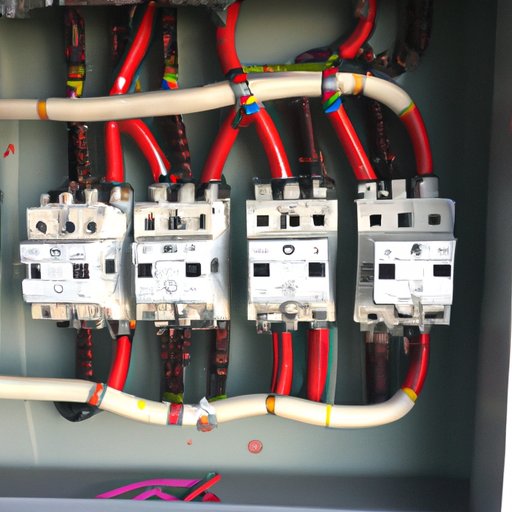Introduction
A Ground Fault Circuit Interrupter (GFCI) is an important component of any electrical system. It is designed to protect people from electrical shocks by detecting ground faults and quickly breaking the circuit. In this article, we will explore the basics of GFCI, its benefits, and how to install one. We will also discuss the science behind GFCI and address some common misconceptions.
Exploring the Basics of GFCI: How Does a GFCI Work?
Before exploring how a GFCI works, it is important to understand a few basic concepts related to electrical currents and circuits. An electrical current is a flow of electrical charge through a conductor, such as a wire or a circuit board. A circuit is a closed loop of conductors that allows the flow of electrical current. In order for electricity to flow, there must be a complete circuit with no breaks in it.
A GFCI monitors the electrical current in a circuit. If there is an imbalance, which can occur when a person comes into contact with a live wire, the GFCI will detect it and break the circuit, preventing the person from being electrocuted. The GFCI does this by comparing the amount of current flowing out of the hot wire to the amount of current returning on the neutral wire. If there is a difference, it indicates a ground fault, and the GFCI will trip, breaking the circuit.
It is important to note that while a GFCI can detect ground faults and trip the circuit, it cannot detect other types of problems, such as an overloaded circuit or an electrical fire. For these types of problems, other safety measures, such as circuit breakers and smoke detectors, should be used.
Understanding the Benefits of GFCI: How Does a GFCI Work?
GFCI has many benefits, both in terms of safety and cost savings. According to the U.S. Consumer Product Safety Commission (CPSC), “Ground fault circuit interrupters are one of the most effective means available to reduce the risk of electric shock.” Not only do GFCIs save lives, but they can also save money. By protecting against ground faults, GFCIs can help reduce the cost of repairs and insurance premiums.
A Step-by-Step Guide to Installing a GFCI: How Does a GFCI Work?
Installing a GFCI is relatively simple, but there are a few things to keep in mind. First, GFCI outlets should be installed in areas where water is present, such as bathrooms, kitchens, and laundry rooms. This is because water increases the risk of electric shock. Second, GFCI outlets must be wired correctly. This includes making sure that the wires are connected to the correct terminals, and that the hot, neutral, and ground wires are properly labeled.
Once the wiring is complete, the steps for installing a GFCI outlet are as follows:
- Turn off the power to the circuit.
- Remove the existing outlet and disconnect the wires.
- Connect the new GFCI outlet’s wires to the circuit wires.
- Mount the GFCI outlet to the wall.
- Turn on the power to the circuit and test the GFCI outlet.
The Science Behind GFCI: How Does a GFCI Work?
Now that we have discussed the basics of GFCI and how to install one, let’s look at the science behind how a GFCI works. A GFCI detects ground faults by measuring the amount of current flowing in and out of the hot wire. If there is a difference in the amount of current, it indicates a ground fault. When a ground fault is detected, the GFCI will trip, breaking the circuit and preventing the person from being shocked.
There are several types of GFCI, each with different capabilities. Standard GFCI outlets are capable of detecting ground faults and tripping the circuit. Some GFCIs also have the ability to detect arc faults and tripping the circuit if an arc fault is detected. Other types of GFCI, such as surge protectors, are capable of protecting against power surges.
Common Misconceptions About GFCI: How Does a GFCI Work?
Despite their importance, there are some misconceptions about GFCI. One common misconception is that GFCI and standard outlets are the same. While both outlets provide electricity, they serve different purposes. GFCI outlets are designed to detect ground faults and prevent electrocution, while standard outlets are not. Another misconception is that GFCI is only needed in wet areas. While GFCI is recommended in wet areas, it is also important to use them in dry areas, as well. Finally, some people believe that GFCI can protect against overloads. However, this is not true. GFCI can only detect ground faults and trip the circuit.
Conclusion
Ground Fault Circuit Interrupters (GFCI) are an important component of any electrical system. They are designed to detect ground faults and quickly break the circuit to prevent electrocution. GFCI has many benefits, including safety and cost savings. Installing a GFCI is relatively simple, but it is important to make sure that the wiring is correct and that the outlet is installed in an appropriate location. Finally, it is important to understand the science behind how a GFCI works and dispel any common misconceptions.
In conclusion, GFCI is an essential part of any electrical system. It is important to understand how a GFCI works and the benefits it provides. With proper installation and understanding of GFCI, you can ensure the safety of your home and family.
(Note: Is this article not meeting your expectations? Do you have knowledge or insights to share? Unlock new opportunities and expand your reach by joining our authors team. Click Registration to join us and share your expertise with our readers.)
